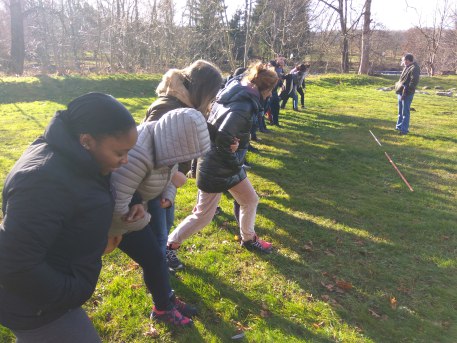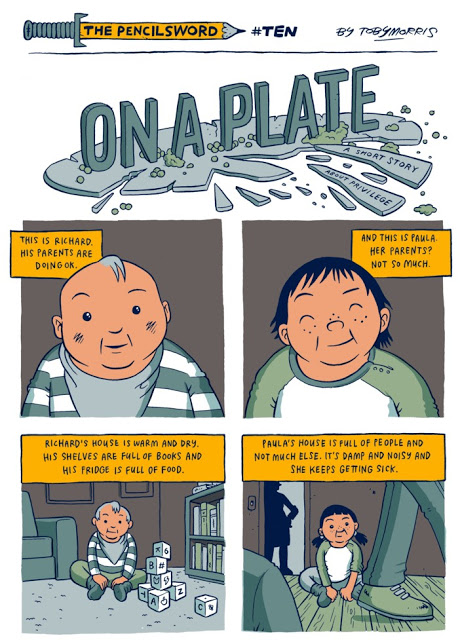

Social Power and Privilege in Society
by Nick Doran on the 08/11/2017
On Thursday, October 26th last, Stephanie Kirwan and Bobby McCormack, of Development Perspectives, hosted a fascinating workshop in the Carmelite Centre in Dublin City. The workshop focused on ‘power’ and ‘privilege’ in society, specifically the invisibility of power and privilege, and how it creates and maintains particular sets of norms and conventions which sustain unequal access to social capital and resources. Under guidance from Bobby and Stephanie, the conversation developed quite organically taking us down an enlightening rabbit hole of issues surrounding topics such as education, social status, language, discourse, rights, duties, obligations, privileges, and responsibilities etc.
There was a broad range of people from different backgrounds in attendance bringing multiple perspectives to the table.
The event inspired me to write about power and privilege in society. So here it is…
(As a quick disclaimer: I am in no way affiliated with Development Perspectives and the views in this article are entirely my own)
“Power” and “privilege” was what was being discussed! But what is it?
Social power is a kind of power that people often consider to be a woolly, unclear concept with no obviously definable parameters. That said it is variously identified and analysed in the context, and terms, of the following: authority (I have power because I say so), meritocracy (I have power because of my skills and abilities), democracy (I have power because you gave me the power), wealth (I have power because I’m rich), social capital (I have power because you all think I’m great), and social structures such as law, and governance (I have power because a bunch of Egyptians started writing philosophy 12,000 years ago, and I’ve followed their traditions studiously).
All of these types of power hold one key similarity: they define who, or what institutions, on societal, cultural, and political levels, hold a predominance of social-capacity, to persuade, influence, control, and manipulate others.
While social power can be carried out through the use of physical force, the kind of power I will address here is that which is enacted through, culture, society, and politics. The engine which runs the functioning of culture, society, and politics, in terms of power, is that of discourse. I have previously defined discourse as:
…a general societal viewpoint or understanding, activated and maintained by, and through, language within a particular socio-historical context. It is viewed as social action and is instrumental in maintaining and creating power in social relations. Concepts, both experienced in reality and experienced through language and discourse, have been shown to activate the same areas of the brain pointing to the power of language and discourse in creating social and political realities and structures. (Doran, 2017)
As mentioned above defining social power can be a tricky task. Despite often being considered as something that is “just the way it is”, there are many competing definitions of social power which stem from different viewpoints; Pluralist, Marxist, Elitist, to list just a few examples. I will not review each of these here but they are worth looking into in order to develop a clearer understanding of different perspectives of social power.
For the purposes of this article, I am using Steven Lukes’ (1974) three-part definition of social power as outlined below.
Social power in three parts.
Dimension 1
The first dimension of power according to Lukes is a simple conceptualisation in the form of A having ‘power over B to the extent that he can get B to do something that B would not otherwise do.’ (ibid: 11-12) For example: ‘give me your lunch money or I’ll give you a dig in the head!’ I might not actually punch you in the head but the point is that the functional use of a verbal threat is often enough to exert immediate control. The other most prevalent mode of dimension-1 power use is persuasion. Although persuasion is not always as obviously intentional as threats. A useful model of analysis to refer to in relation to persuasion is Herman and Chomsky’s (2002) ‘Propaganda Model’ in their book ‘Manufacturing Consent’.
The first dimension is a relatively straightforward conceptualisation of power as control. This type of power operates, all things being equal (assuming everything relevant remains the same), in a context whereby both A and B understand the situation but B is nonetheless in a weaker position. If all things were not equal then, for the sake of argument in the context of the threat, B might have a (metaphorical) gun hidden behind his back. This would obviously change the premise of the point being made. Lukes highlights that the litmus test for this type of power is a simple quantitative (numerical count) analysis of how often a person or institution overtly and successfully persuades others to follow their line.
Dimension 2
The second dimension of power brings forward the notion of ‘mobilisation of bias’ which analyses how those for whom the ‘rules of the game’ work best ‘are placed in a preferred position to defend and promote their vested interests.’ (I have power because I can shout the loudest using my social capital and access to social resources which I attained with my usually already accumulated social power and/or wealth) <- this sounds like a circular argument (A causes B which causes A) which I’ll come back to later, and explain further. This pseudo-circular development of social power through discourse is an important concept to grasp in understanding how social power dynamics sustain inequalities.
For the moment, however, the second dimension of power can be regarded as a kind of power that maintains the status quo. Richardson (2007) explains it effectively as, ‘the power to make non-decisions.’ That is to say, power is used to stop contestations to the ‘current’ power structures. So those in power maintain an attitude that metaphorically resembles an ‘if it’s not broken, don’t fix it’ approach. Of course, current power structures are less likely to seem broken from the perspective of those who gain most from social power dynamics remaining the same. A key aspect of this state of power relations is that indicators of power inequality are overtly recognisable, and attempts can be made to address them. However, creating a discourse which will lead to change and which will be accepted on a democratic level is difficult since, for example, large media organisations are powerful arbiters of what is, and is not allowed into public consciousness.
Dimension 3
The third dimension of power in Lukes’ theoretical model is perhaps the most effective in maintaining social and cultural norms in favour of those who already maintain positions of power. The third dimension of power operates at a level whereby power relations are normalised into social, cultural and political structures. So while other forms of power inequality might be recognisable, or at least discoverable to the marginalised party, the third face of power is normalised to a point within social structures that it goes unnoticed and therefore unquestioned thus preventing ‘conflict from arising in the first place.’
Lukes describes this type of power as a systemic phenomenon. The third dimension of power is the kind which is normalised in society. It exists unquestioned since it is accepted by both those for whom the power structures work, and by those for whom they don’t. In other words, it is regarded as ‘just the way it is’.
That’s Just the Way it is!
Discourses epitomised by the expression “that’s just the way it is” are particularly relevant here. They are used on one level – amongst those for whom social and political structures don’t work – as acceptance, and on another level – amongst those for whom social systems do work – as a defence. These discourses have been used over and over again in history to rationalise and defend status quo power structures that maintained systems of racism, apartheid, sexism, ageism etc… all of which are grounded in ideologically based, discursively constructed inequalities in social power structures.
This brings me back to the circularity of power structures mentioned above. This part of Critical Discourse Analysis can be a bit mind-melting, but please bear with me.
Social power structures are inextricably linked to discourses of the kind mentioned earlier. They inherently affect each other. But how do they affect each other? And how, and where does it all begin?
Discourses, or cultural modes and practices of language, contribute to the shaping of political and social power structures by continuously shifting definitional, and functional terms upon which the social power structures are based. Social and political power structures, in turn, contribute substantially to discursive constructions of social norms: they are defined by and define discourse.
Take the discourse surrounding education and social mobility in Ireland. Social mobility in Ireland is ostensibly reliant upon a system of meritocracy: work hard, pass milestones, succeed. Discourses surrounding meritocracy are based on the notion that if one works hard at what they do, they will succeed.
In light of this, a pertinent example of how power and privilege within certain areas of society perpetuate power and privilege for those areas is the private education system. This system proffers social and economic advantage to certain groups of young people in society. This, in turn, opens up further opportunities affording them greater social power and its attendant status. These privileges are passed on to their next generations via structures of economic and social capital. Social mobility within systems like this is evidently difficult. So in this sense, private education can be re-conceptualised as a threat to social mobility and equality.
There are many socio-linguistic (language function through society), and psycho-linguistic (language function through mental capacities), and historical processes involved in the development and maintenance of societal conventions such as that which accept private education as a norm in society. Underlying all of these processes, however, is the aforementioned functioning of power-through-discourse which places certain groups of people in privileged positions in society, thus allowing them more access to social capital and resources which in turn favours the orders of power which allow them privileges in the first place.
The unseen privileges of social power.
Social power in society affords those who benefit from it many privileges which are so conventionalised in their mental frameworks for understanding day to day life and society that they are not considered privileges but rather simply routine. When there is a perceived threat to systems of power which sustain these privileges then tensions emerge along class, gender, race, cultural, social, political and geographical divides – the current situation developing between Catalonia and Spain is indicative of this.
The effects of social power imbalances and inequalities are evident all around us, all the time, and are epitomised globally by how free market capitalism facilitates profiteering based upon cheap and unethical labour policies, and, furthermore in struggles for access to universal education standards and health care. These rights are fundamental to the social contract which ideally strives towards the development of an ethical, equitable society where everyone has access, from an early age to essential resources needed to create a living which is in line with the Universal Declaration of Human Rights.
Social, political and economic systems that are created for humans, are created by humans, to benefit humans. Currently, those systems disproportionately benefit certain sections over others, both globally and in local societies. A crucial problem that has created resistance to all emancipatory movements is the perception that, because one element of society demands more rights and powers, another element of society (usually the ones who hold power) will lose out. But, it is not a zero sum game, or at the very least does not need to be.
A move towards a solution to the problems entailed in unequal access to social and economic resources would be introducing compulsory critical thinking modules into the schooling system in Ireland from early on in formal educations processes. This would go a long way to emancipation from discourses, power structures, and cultures which offset social and monetary gain for the benefit of the few.
During the Development Perspectives workshop, Bobby pointed out that critical thinking is already integrated into aspects of individual courses as part of the syllabus. Also, a philosophy elective was recently introduced to the curricula in Ireland. It is heartening that this is the direction education is moving, however, critical thinking ought to be recognised as a skill in itself. I believe that society stands to benefit greatly from the paradigm shift which a focus on critical thinking would bring.
On one final note, this article was inspired by the discussion facilitated by Bobby and Stephanie from Development Perspectives. There were some stimulating issues raised by everyone present and I think we all came away from the workshop a little wiser for it.
One final, final note to add to the previous final note: a cartoon by Toby Morris that addresses power and privilege is attached below. The concepts and processes are nicely encapsulated with the narrative aid of images.

0 comments
No comments on this blog yet. Would you like to be the first?